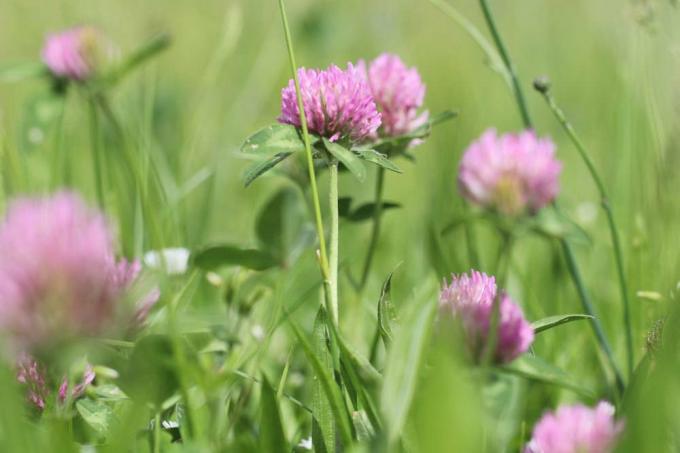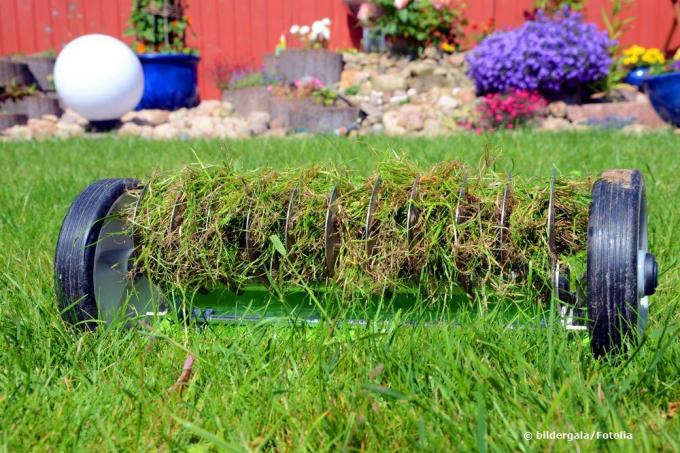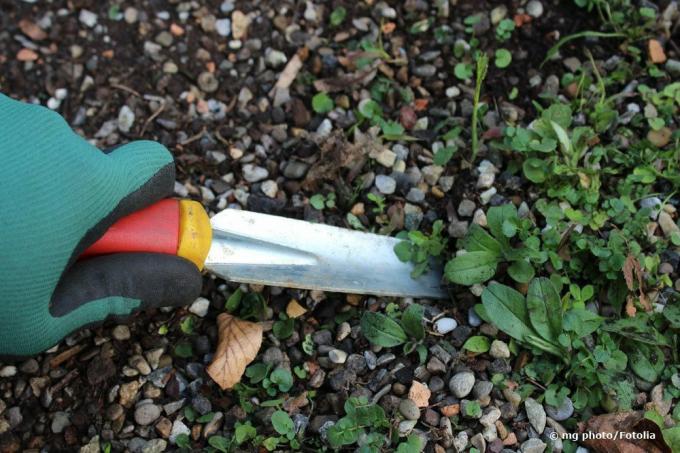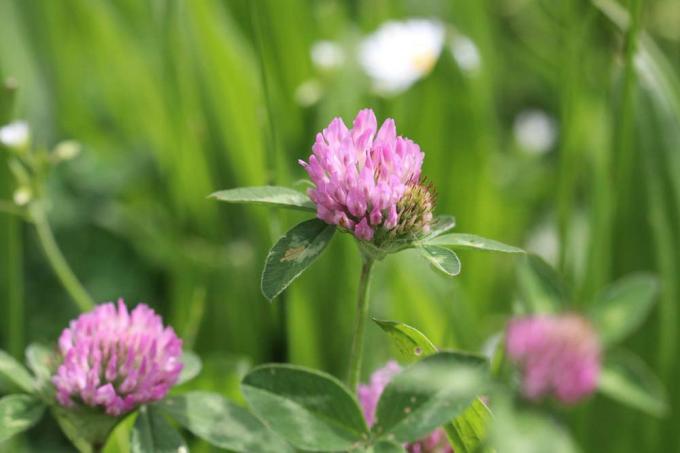
table of contents
- Red clover in the lawn
- Measures to combat
- Scarify the lawn
- Cutting out by hand
- Application of a plastic tarpaulin
- If nothing helps
- Use of chemical agents
- Change soil conditions
- Prevent clover growth
- Fertilize properly
The pink, spherical inflorescences of the red clover (Trifolium pratense), also known as meadow clover, are beautiful to look at between the months of May to October. The clover is not only used as a fodder plant, but also in folk medicine and the flowers are also very popular with bees as a source of pollen. However, red clover can also become a plague very quickly if it is in the race broad power. The herbaceous growth is then very difficult to control.
Red clover in the lawn
The native plant can grow up to 80 cm high and the tap roots of the red clover reach up to 2 meters deep into the ground. In addition to self-sowing, it also spreads rapidly underground through runners, the so-called rhizomes, and takes away light, space and nutrients from the lawn plants. Ultimately, the clover then completely displaces the grass. Red clover is extremely robust and, especially with weakened grasses, it can quickly gain a foothold
- the balance of the soil is disturbed
- high soil pH values are present
- Nutrients are missing
- the care is inadequate
Note: Excessively high soil pH values are ideal growth conditions for Trifolium pratense. Low-nitrogen and loamy soils are particularly affected.
Measures to combat
Red clover is very stubborn and fighting it can be very difficult because it is deeply rooted in the earth. The plant must always be completely removed. Even small pieces of root that remain in the ground can stimulate new shoots. Below are various measures to remove red clover from the green space. Sometimes a combination of different control methods makes sense.
Scarify the lawn
A strong one Weed growth inhibits the development and growth of lawn plants. Here can be a Scarifying of the soil will be helpful. During this process, lawn thatch, clover, dead plants and also moss are mechanically removed and the soil is loosened at the same time. Water and oxygen can then reach the roots of the lawn plants unhindered.
- best time in spring
- Process surfaces several times
- Apply new lawn seeds to bald spots
- then water well and fertilize
Electric or petrol scarifiers should be used for larger areas, as this work can be very strenuous. These devices can be borrowed from garden centers and hardware stores.

tip: With the scarifier you should work the surface once lengthways and then once across. This is how it is most effective to pull out clover.
Cutting out by hand
This method is well suited to control red clover in small areas. However, the time required and the physical strain are relatively high. A longer kitchen knife can be used for cutting out. In addition, special weed pickers in the shape of a shoehorn with a long handle are available in stores. The cutting out of the red clover should always be repeated several times.
- Cut out the entire root
- repeat regularly
- Fill the holes with a mixture of earth and sand
- Re-sow the lawn on bare spots
- Use of special reseeding mixture
- then water sufficiently
- important for good germination
- Spreading of fertilizer

tip: Red clover must always be removed mechanically first. Otherwise other measures cannot work.
Application of a plastic tarpaulin
Alternatively, a large plastic tarpaulin can be stretched over the affected lawn area. This method is very effective and environmentally friendly. A normal, darker groundsheet from the hardware store can be used for this.
- Fixation of the foil with stones or tent pegs at corners
- Period of at least four weeks
Due to the lack of light and also lack of oxygen, red clover will die within this time. However, there is also the possibility that the lawn will be affected. As a rule, however, he usually recovers. If this is not the case, then one is Overseeding advisable.
Note: Snails and others like to hide under the tarpaulin insects find shelter.
If nothing helps
If there is an excessive amount of red clover, however, only a complete one is usually recommended Lawn renewal. To do this, it is necessary to carefully remove all the roots of the meadow clover. Even the smallest remaining root remains can sprout again. The roots should therefore not be disposed of on the compost heap, but rather in the residual waste.
The floor may need to be completely replaced. To do this, proceed as follows:
- best time in spring or late summer
- Remove the soil 30 to 50 cm deep
- Removal of all roots and stones
- Sieve soil several times through a coarse sieve
- then again through a fine sieve
- Mix soil with fresh humus or compost
- Apply soil mixture to the area
- compact well
- Re-sow the lawn
- water well and keep moist
Use of chemical agents
Just a few brief explanations for information. If possible, chemical agents should be avoided. they are not very environmentally friendly. Sometimes they can also be dangerous for bees and other insects. The commercially available clover killers in the lawn are based on the destruction of dicotyledonous plants such as meadow clover. They are not harmful to monocot plants such as grass. You should always pay attention to which active ingredients are included. These must be effective against red clover or against dicotyledon weeds in general. The use is made
- according to package instructions
- Do not mow the lawn beforehand
- Use on warm days
- Means works through leaves
- stimulates rapid growth of plants
- this causes the metabolism to collapse
- Use on rain-free days
- otherwise washing off of the agent
- water the lawn the evening before
- Short-lived effects
- Repeat every three to five weeks
- Remove dead plants
- Re-sow the lawn
- Fertilization with phosphate-free fertilizer
However, as already noted, chemical agents should really only be used in emergencies, when nothing else will help.

tip: A good home remedy for controlling red clover in lawns is boiling hot water. Pour this on the affected area, let it dry and finally remove the dead plant.
Change soil conditions
However, red clover cannot be removed from the lawn simply by pricking and scarifying, as the roots protrude deep into the ground. In addition, the soil conditions have to be changed. In other words, all growing conditions for the meadow clover must be worsened.
Optimizing the pH of the soil
- light garden soil pH 6.0
- heavy soils pH around 7.0
- Lower the lime content of the soil
- For example, adding leaf soil or rotted pine needles
- targeted fertilization
- Ventilation of the lawn
If there is pronounced clover growth on normal garden soil, it can be assumed that the soil is too calcareous. The pH is above 7.0, ideal for red clover. Furthermore, there is no water storage here and there is a lack of nutrients for the lawn plants. It is always advisable to determine the pH value. For this purpose, a soil sample can be analyzed in the laboratory. In addition, the determination is also possible with a pH value test set from the hardware store. Depending on the result, appropriate measures can then be taken.
Prevent clover growth
An important measure here is to increase the lawn growth. Only with healthy and strong lawn plants does clover have no way of spreading. Appropriate maintenance is necessary for this:
- scarify in spring
- thereby removal of root felt, dried-up material and moss
- Stimulates the formation of a closed sward
- Water regularly during dry periods
- Drought weakens lawn roots
- best time early evening or morning hours
- evenings only on hot days
- otherwise fungal attack possible on cool nights
- avoid watering during the midday heat
- mow regularly
- once or twice a week depending on growth
- no deeper than 3 to 5 cm
- ideal cutting height 4 cm
Note: If the cutting height is too low, the lawn plants lack the appropriate leaf mass to be able to regenerate. Red clover, on the other hand, needs a lot of light to grow. Low cutting heights would therefore accelerate its growth. A correct supply of nutrients is also necessary for a good strengthening and good growth of the lawn and at the same time avoiding the spread of red clover.
Fertilize properly
With the help of fertilizer, the grass plants are supplied with the necessary nutrients. There should be three fertilizations: in April, in June and in mid-October. The application of fertilizer is especially important after the winter before new growth. Nitrogen is then essential for the formation of a dense sward. In addition to uniform growth, this also ensures protection against burns in summer and counteracts clover growth.
- Use of long-term fertilizer with a high nitrogen content
- Phosphate content should be low
- Phosphate accelerates the growth of clover
- Prefer organic fertilizers such as horn shavings or horn meal (long-term effect)
- Special mineral lawn fertilizers with a low phosphate content are also possible
- use fertilizers containing potassium in autumn
- offer protection from cold and drought
- Spring nitrogenous fertilizers to accelerate growth
- Even application with a spreader or liquid fertilizer with a watering can
- Fertilize shortly before the rainy season
- no rain in sight, water in advance
- But grass stalks must be dried off
- not on dry ground and in blazing sun
- best time early morning or late afternoon
Hobby gardeners also like to use lime. The lawn should only limed if a soil analysis is available. Otherwise the surface can easily become over-lime, which in turn helps the growth conditions of Trifolium pratense.

Note: Pale blades of grass and the excessive presence of weed in the lawn are the first signs of a lack of nutrients. It is then time to fertilize.



